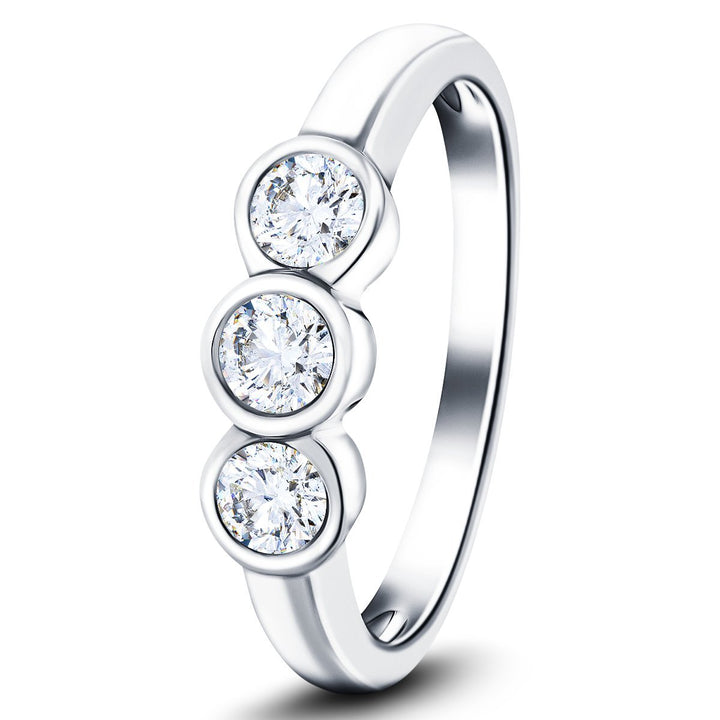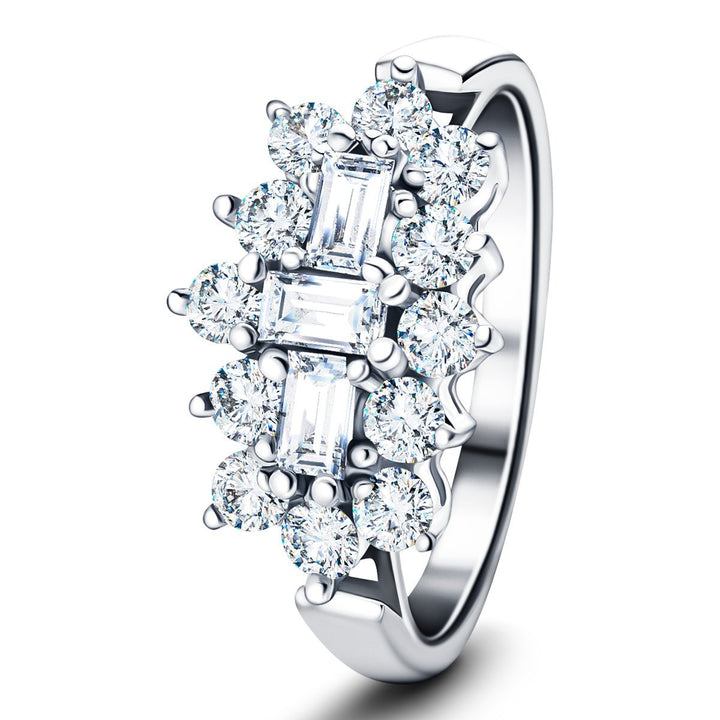How Diamond Ring Settings Change The Look Of Your Diamond Jewellery
Of all the elements that make a beautiful piece of fine diamond jewellery, the diamond ring settings chosen by the designer are probably the most important. The way the precious stones, diamonds, emeralds, sapphires and rubies are set into the precious metal, the setting chosen by the jewellery designer can completely alter the appearance of the jewellery
The designer has two main objectives when setting the diamonds into the jewellery. The first is to mount the gemstones securely, and the second is to maximise the brilliance of the diamond by showing off its cut, colour and clarity.
This article will describe the diamond ring settings you will most likely see when looking at fine diamond jewellery.
The Prong Setting
 The prong setting is undoubtedly the most popular setting for both the side and centre diamonds (or other precious stones) in modern jewellery. There are several reasons for the popularity. The prong setting uses 4 or 6 claws, depending upon the size of the gem, that forms a secure cradle around the diamond.
The prong setting is undoubtedly the most popular setting for both the side and centre diamonds (or other precious stones) in modern jewellery. There are several reasons for the popularity. The prong setting uses 4 or 6 claws, depending upon the size of the gem, that forms a secure cradle around the diamond.
This setting maximises the amount of light entering the diamond from all angles, including below the stone. The openness of the setting emphasises the diamond and makes it look larger than settings that cover more of the stone.
The Rub Over or Bezel Setting
The rub over setting uses a bezel that surrounds the diamond to hold it in place. The bezel may be straight, scalloped or formed into any shape to fit snugly around the stone.
A bezel setting may have a closed back or be open to allow light to pass through the diamond. Bezel settings flexible in application and are found on rings, earrings, necklaces, and bracelets.
If you are buying a diamond with a warm rather than completely white colour grade, a yellow gold bezel setting can look perfect as the diamond picks up the yellow colour of the metal. Conversely, a white diamond will be enhanced by the use of platinum or white gold.
are buying a diamond with a warm rather than completely white colour grade, a yellow gold bezel setting can look perfect as the diamond picks up the yellow colour of the metal. Conversely, a white diamond will be enhanced by the use of platinum or white gold.
Channel Setting
The channel setting sets the diamonds immediately next to each other with no visible metal between them. The outer edge of the ring is then formed over the edges of the diamonds to hold them in place. This technique protects the delicate girdle of the diamond and gives a smooth external surface making it ideal for wedding and engagement rings that are likely to be worn every day.
visible metal between them. The outer edge of the ring is then formed over the edges of the diamonds to hold them in place. This technique protects the delicate girdle of the diamond and gives a smooth external surface making it ideal for wedding and engagement rings that are likely to be worn every day.
Bar Settings

The bar setting is quite similar to the channel setting. The significant difference is that there are two diamonds set next to each other, separated by a bar running across the width of the ring. This bar arrangement enables smaller diamonds to be used, creating the effect of larger stones. The external girdle is open in the bar setting but the diamonds are protected by the crossways running precious metal bars.
The bar setting is a trendy choice for anniversary rings and for wedding rings in the United States. The style is also very effective when used in bracelets and necklaces.
Pave Setting
In the pave setting style, small stones are set closely together, each separated with tiny metal beads. Pave settings can surround a modest centre diamond giving the impression of a much larger stone.
Pave settings allow light to reflect off the large
number of facets giving a brilliant effect. The actual setting technique uses tiny prongs to hold each small diamond in place almost invisibly. This style is often found on earrings and engagement rings, but of course, it can be found on other jewellery types.
The Tension Setting
The tension setting is a visually striking way to mount gems onto a piece of jewellery because there is no visible fixing to the ring. There is no bezel, channel or prongs. Instead, the diamond is held by the tension exerted by the spring pressure created in the ring.
The diamond appears to float in the gap between the open ends of the ring with nothing holding it in place. In truth, there are tiny grooves etched into the precious metal to create a ledge upon which the diamond sits to stop the diamond from being dislodged under impact.
Tension settings have become very popular in modern engagement ring designs because they give a clean, simple, yet intriguing look to the ring.
Flush Or Gypsy Setting
The flush setting is popular in male jewellery, where there is often an expectation that the ring will encounter a more challenging life than female jewellery. In this setting style, the diamond is set into a recess in the precious metal. The metal is then pushed over the sides of the stone, leaving only the top of the diamond visible, often with a small recess.
precious metal. The metal is then pushed over the sides of the stone, leaving only the top of the diamond visible, often with a small recess.
This style does not give much sparkle to a diamond as very little light can enter the stone but can still give a charming and yet more masculine effect.
Invisible Settings
As the name suggests, invisible settings give the appearance of a diamond floating on the ring with no visible fixing. There are no bezels or prongs to be seen, giving the impression of an uninterrupted field of diamonds.
The diamonds are held in place from below using a small groove cut into the base of each diamond. The groove matches up to a raised track that holds the gem in place against its neighbours.
This style can give a striking visual effect with baguette, emerald, princess, and square-shaped diamonds. The method cannot be used with diamonds with round cut or other shapes with rounded edges. Invisible settings are challenging to create but have the advantage of making smaller diamonds look larger due to the lack of visible metal, giving a more expensive effect.
Bead Settings
Bead settings use holes drilled into the surface of the piece of jewellery. As with the flush setting, the gemstone is set into a recess in the metal and the precious metal is then pushed up and over the edge of the diamond forming small prongs to hold it in place.
18k White Gold 1.00ct G/SI Diamond Three Stone Bezel Set Ring

$3,429.00
$6,196.00
This elegant three-stone ring is the perfect gift for someone you love. A classic yet sophisticated ring that is sure to impress and make a statement. This unique piece is crafted from 18k white gold and has an impressive three… read more
The significant differences between gypsy and bead settings are the scale involved and the visual effect. In a flush/gypsy setting, there is typically just one diamond set into a ring. With bead setting, many smaller diamonds are set to create a field of diamonds with an effect similar to pave setting and often used in the same way to support and enhance a central diamond or other gemstones.
Cluster Settings
 Cluster settings are diamonds set together in a group. Often the gemstones are raised above the surface of the ring in an abstract form or a stylised design such as a flower. The gems may be clustered close together or spaced apart, giving a much more striking effect. Designers often use this style to create the effect of a larger diamond from the arrangement of smaller stones. The clustering of the gems gives the whole piece increased sparkle and size. If you want a striking piece of jewellery, go for a cluster design!
Cluster settings are diamonds set together in a group. Often the gemstones are raised above the surface of the ring in an abstract form or a stylised design such as a flower. The gems may be clustered close together or spaced apart, giving a much more striking effect. Designers often use this style to create the effect of a larger diamond from the arrangement of smaller stones. The clustering of the gems gives the whole piece increased sparkle and size. If you want a striking piece of jewellery, go for a cluster design!
Diamond Cluster Boat Ring 0.50ct G/SI Quality in 18k White Gold

$1,410.00
$2,049.00
Our UK artisans have combined 0.50ct of G/SI quality diamonds with British hallmarked 18k white gold to achieve this stunning boat ring with a peerless sparkle and shine. The baguette-cut diamond stones are framed with round-cut diamond stones to create… read more
As you can see, the type of setting can significantly impact the look of your jewellery, so don’t just choose the classic prong setting. Look for the slightly less common styles because you will probably find something more striking or possibly makes better use of your budget by doing so.
At All Diamond, we have collections of diamond jewellery that feature the styles described above. Please take a few minutes to browse our collections. You might find yourself falling in love with one of our designs that you had not previously considered or even seen!




